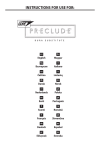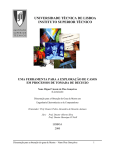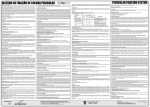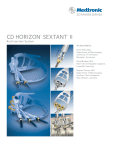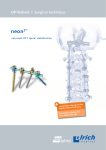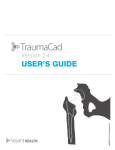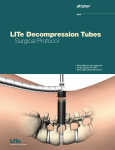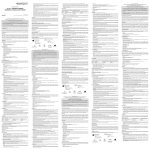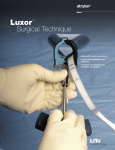Download Spine Tango User's Manual Part I: Dictionary of Terms
Transcript
Spine Tango User’s Manual Part I: Dictionary of Terms Surgery Version 2011 and Follow up T. Zweig1, 2 M. Neukamp1, A. Mannion3,5, C. Röder1,5, E. Munting4,5, D. Grob3,5 1. Institute for Evaluative Research in Medicine, University of Bern, Switzerland 2. Orthopedic Department, Kantonsspital Schwyz, Switzerland 3. Spine Unit, Schulthess Klinik Zurich, Switzerland 4. Orthopaedic Department, Clinique Saint Pierre Ottignies, Belgium 5. Spine Tango Committee EuroSpine, the Spine Society of Europe Spine Tango Dictionary of Terms; V. 2.3; April 2012 Spine Tango User’s Manual - Part I: Dictionary of Terms Surgery 2011 and Follow up SURGERY FORM: .............................................................................................................................................. 4 FORMAT.............................................................................................................................................................. 4 LEVEL OF MAIN PATHOLOGY* ............................................................................................................................ 4 ADMISSION/PATHOLOGY .............................................................................................................................. 4 ADMISSION* ....................................................................................................................................................... 4 MAIN PATHOLOGY .............................................................................................................................................. 4 SPECIFICATION OF MAIN PATHOLOGY ................................................................................................................. 5 degenerative Disease ..................................................................................................................................... 5 Type of degeneration ...................................................................................................................................... 6 Deformity ....................................................................................................................................................... 7 Type of deformity ........................................................................................................................................... 7 Type of scoliosis ............................................................................................................................................. 8 Predominant etiology ..................................................................................................................................... 8 (Pathological) Fracture/Trauma ................................................................................................................... 9 Type of (pathological) fracture/trauma.......................................................................................................... 9 Dens fracture type ........................................................................................................................................ 10 C3-L5/S1 AO fracture type .......................................................................................................................... 11 Pathological fracture due to… ..................................................................................................................... 12 Fracture age................................................................................................................................................. 12 Spondylolisthesis .......................................................................................................................................... 13 Type of spondylolisthesis ............................................................................................................................. 13 Grade of Spondylolisthesis........................................................................................................................... 14 Inflammation ................................................................................................................................................ 14 Type of inflammation ................................................................................................................................... 14 Criteria for the Classification of Acute Arthritis of Rheumatoid Arthritis (American College of Rheumatology) ............................................................................................................................................. 15 Infection ....................................................................................................................................................... 16 Infection specification .................................................................................................................................. 16 Affected structures........................................................................................................................................ 16 Tumor ........................................................................................................................................................... 16 Type of Tumor .............................................................................................................................................. 16 Localisation.................................................................................................................................................. 17 Specify type of tumor .................................................................................................................................... 17 Repeat surgery ............................................................................................................................................. 17 Type or reason of repeat surgery ................................................................................................................. 17 MOST SEVERELY AFFECTED SEGMENT/ VERTEBRAL BODY ................................................................................ 18 EXTENT OF LESION ........................................................................................................................................... 18 ADDITIONAL PATHOLOGY ................................................................................................................................. 19 NO. OF PREVIOUS SPINE SURGERIES .................................................................................................................. 19 Previous surgery at the same level............................................................................................................... 19 Previous surgery at the same hospital ......................................................................................................... 19 Previous treatment for main pathology........................................................................................................ 20 RISK FACTORS .................................................................................................................................................. 20 Presence of flags – for LBP patients ............................................................................................................ 21 Occupational and societal factors, .............................................................................................................. 22 not matters of perception, affect all workers equally:.................................................................................. 22 SURGERY........................................................................................................................................................... 22 Surgery Date ................................................................................................................................................ 22 SURGICAL PROCEDURE ..................................................................................................................................... 22 Therapeutic goals......................................................................................................................................... 22 Anterior access............................................................................................................................................. 23 Posterior access ........................................................................................................................................... 23 Components.................................................................................................................................................. 24 - component description ............................................................................................................................... 24 2 page Spine Tango User’s Manual - Part I: Dictionary of Terms Surgery 2011 and Follow up Surgeon credentials...................................................................................................................................... 24 Morbidity State............................................................................................................................................. 24 Technology ................................................................................................................................................... 26 Operation time ............................................................................................................................................. 27 Prophylaxis .................................................................................................................................................. 27 Blood loss ..................................................................................................................................................... 27 Blood transfusion ......................................................................................................................................... 27 units .............................................................................................................................................................. 27 cell saver ...................................................................................................................................................... 27 SURGICAL MEASURES .................................................................................................................................. 27 DECOMPRESSION .............................................................................................................................................. 27 FUSION ............................................................................................................................................................. 28 Fusion material ............................................................................................................................................ 29 STABILIZATION RIGID ....................................................................................................................................... 30 STABILISATION MOTION PRESERVING ............................................................................................................... 31 PERCUTANEOUS MEASURES .............................................................................................................................. 31 OTHER SURGICAL MEASURES ............................................................................................................................ 32 EXTENT OF SURGERY – INDICATE AS: ............................................................................................................... 32 INTRAOPERATIVE SURGICAL COMPLICATIONS .................................................................................................. 33 SURGICAL MEASURES DURING INDEX SURGERY ................................................................................................ 33 INTRAOPERATIVE GENERAL COMPLICATIONS ................................................................................................... 33 HOSPITAL STAY .............................................................................................................................................. 34 POSTOPERATIVE SURGICAL COMPLICATIONS BEFORE DISCHARGE .................................................................... 34 POSTOPERATIVE GENERAL COMPLICATIONS BEFORE DISCHARGE ..................................................................... 34 RE-INTERVENTION AFTER INDEX SURGERY ....................................................................................................... 35 Hospital stay ................................................................................................................................................ 35 Status of complications ................................................................................................................................ 36 Therapeutic goals upon discharge ............................................................................................................... 36 FU foreseen .................................................................................................................................................. 36 Discharge date ............................................................................................................................................. 36 FOLLOW-UP ..................................................................................................................................................... 36 LEVEL OF INTERVENTION*................................................................................................................................ 36 FU INTERVAL ................................................................................................................................................... 37 WORK STATUS .................................................................................................................................................. 37 THERAPEUTIC GOALS / MEASURES .................................................................................................................... 37 ACHIEVED ........................................................................................................................................................ 37 PARTIALLY ACHIEVED ...................................................................................................................................... 37 NOT ACHIEVED ................................................................................................................................................. 37 MEDICATION .................................................................................................................................................... 38 OVERALL OUTCOME (EXAMINER) ..................................................................................................................... 38 REHABILITATION .............................................................................................................................................. 38 DECISION .......................................................................................................................................................... 39 COMPLICATIONS* ............................................................................................................................................. 39 3 page Spine Tango User’s Manual - Part I: Dictionary of Terms Surgery 2011 and Follow up Surgery Form: Format minimal Minimal data set, all questions with white background are excluded. complete Complete data set, all questions must be answered. Level of main pathology* upper cervical C0-C2 mid/lower cervical C3-C7 cervicothoracic including C7 and T1 thoracic T1-T12 thoracolumbar including T12 and L1 thoraco-lumbo-sacral including T12-lumbar and S1 lumbar L1-L5 lumbo-sacral including L5 and S1 sacral S1-S5 coccyx Os coccyx *Number of levels in the section has priority: Pathology from C0-C3: upper cervical Pathology from C0-C6: mid/lower cervical Admission/Pathology Admission* date of admission* format: Day/Month/Year (DD/MM/YYYY) *days are counted 0000hrs-2400hrs. Main pathology single answer same as stage 1 surgery If yes: excludes „specification of main pathology“. (This item is only on the surgery staged 2011 form) 4 page Spine Tango User’s Manual - Part I: Dictionary of Terms Surgery 2011 and Follow up degenerative disease Pathology without apparent changes other than those due to aging. deformity Clinically relevant scoliosis or deviation of sagittal alignment (more than two segments). fracture/trauma Fracture or discoligamentous injury as sequelae of trauma. pathological fracture Fracture/dislocation due to pathologic conditions of bone (tumor, osteoporosis etc.). spondylolisthesis (non Vertebral slippage including segmental rotational degenerative**) displacement. inflammation Pathology due to rheumatic diseases (e.g. RA, ankylosing spondylitis, psoriasis etc.). infection Affection due to microorganisms. tumor Includes paravertebral soft tissue, bone and neurogenic tumors of the spine. repeat surgery Any repeat surgery related to the index treatment/ operation. other Any other condition that does not fit the aforementioned pathologies. **Degenerative spondylolisthesis: includes by definition degenerative changes and spondylolisthesis. If there is a typical degenerative spondylolisthesis, e.g. vertebral slippage due to wear and tear of the facets without anatomical changes of the pars interarticularis, tick “degenerative disease” as main pathology and specify as “degen. Spondylolisthesis”. If there is both degenerative spondylolisthesis. and spinal stenosis you can now choose both since the Type of degeneration is a multiple choice question. Specification of main Specify only in relation to items in the section corresponding to pathology the chosen “main pathology” . degenerative Disease 5 page Spine Tango User’s Manual - Part I: Dictionary of Terms Surgery 2011 and Follow up Multiple answers allowed, but only in relation to the main pathology. These questions serve to improve the definition of Type of degeneration „main pathology“ and to establish subgroups for later more differentiated identification. disc herniation/ protrusion Disc material within the borders of the spinal canal either connected to the disc space (bulging, protrusion) or separated from it (sequester). For further classification please tick: “other” and categorise. central stenosis Central narrowing of the spinal canal due to e.g. hypertrophy of the yellow ligament (lig. flavum) or bony restriction caused by enlargement of the facet joint (osteoarthrosis), osteophyte formation, or degenerative spondylolisthesis 6 page Spine Tango User’s Manual - Part I: Dictionary of Terms Surgery 2011 and Follow up lateral stenosis Narrowing of the lateral recess of the spinal canal caused by e.g. disc height decrease,posterolateral disc protrusion or hypertrophy of the superior articular process. foraminal stenosis Narrowing of the foramen , intraforaminal stenosis with nerve root compression. degenerative disc disease Degeneration of the intervertebral disc. Disc related pathology, e.g. loss of height, end plate modifications, intra-discal gas, etc. (Changing in the disc metabolism may lead to cellular changes, matrix degradation and structural damages occurring in disc degeneration). deformity Deformation of the spine due to degenerative changes e.g. scoliosis, kyphosis. Please specify type of deformity!! degenerative spondylolisthesis Spondylolisthesis due to degenerative changes, e.g. vertebral slippage due to wear and tear of the facets without anatomical changes of the pars interarticularis. Please specify grade of spondylolisthesis! other instability Hypermobility / loss of stiffness in a motion segment (not spondylolisthesis) caused by degenerative changes. myelopathy Gradual loss of nerve function caused by progressive narrowing of the spinal canal. facet joint arthrosis Spondylarthrosis, degenerative changes (osteoarthritis) of the facet joints. other Any other condition that does not fit the aforementioned pathologies. Deformity Type of deformity 7 page Spine Tango User’s Manual - Part I: Dictionary of Terms Surgery 2011 and Follow up scoliosis Coronal spinal curvature of at least 10° with rotation of the vertebral bodies of unknown origin (Def. Cobb, 1948). Cobb: Classifications: Infantile (0-3 years; IIS) Juvenile (3-10 years; JIS) Adolescent (10-18 years; AIS) Adult (>18 years) onset: primary degenerative or de Novo Reference: Cobb, J.R.; Outline for the Study of Scoliosis. Instructional Course Lectures, The American Academy of Orthopaedic Surgeons. Vol. 5, pp.261-275. Ann Arbor, J. W. Edwards, 19488 kyphosis The Scoliosis research Society proposes to regard 10-40 degrees as the range for normal kyphosis between the upper endplate T5 and the lower endplate T12. combined scoliosis and kyphosis Type of scoliosis single curve one single curve double curve two curves: Major curve: curve with the largest Cobb angle Minor curves may be compensatory. In the case of combined aetiology, indicate the most prominent. Predominant etiology 8 page Spine Tango User’s Manual - Part I: Dictionary of Terms Surgery 2011 and Follow up idiopathic Arising spontaneously or from an obscure or unknown cause. congenital Failure of formation, failure of segmentation, or mixed. neuromuscular Neuropathic or myopathic conditions (e.g sub-classification: Lonstein et al: Group I: Double thoracic and lumbar curves Group II: Large lumbar or thoraco-lumbar curves). degenerative de novo, secondary degenerative posttraumatic Defective structure due to a trauma or fracture. M. Scheuermann Scheuermann`s disease (Type I, “classical” Scheuermann`s) is a thoracic or thoracolumbar hyperkyphosis due to wedged vertebrae developing during adolescence. Atypical Scheuermann`s disease (Type II, “lumbar” Scheuermann`s) affects the lumbar spine and or the thoracolumbar junction. It is a growth disturbance of the vertebral bodies without significant wedging causing loss of lumbar lordosis or mild kyphosis. other → specify In the case of multiple fractures with different types please use (Pathological) Fracture/Trauma separate forms for each category, if different treatment modalities are used. Type of (pathological) fracture/trauma condylar C0 fracture of the occipital condyle Classification: Type I; II und III C0/C1 dissociation atlanto-occipital dissociation C1 fracture fracture of C1 C1/2 Instability instability between C1 and C2 C2 dens fracture → specify dens fractures type C2 other fracture C2 fractures excluding dens fractures soft tissue injury neck Whiplash injury: post traumatic cervicalgia without demonstratable tissue lesions by Xrays or MRI. fracture C3-L5/S1 → specify AO fracture type 9 page Spine Tango User’s Manual - Part I: Dictionary of Terms Surgery 2011 and Follow up sacrum fracture fracture os sacrum other → specify Specify according to the classification Anderson and d’Alonzo. Dens fracture type I II III Reference: Anderson LD, D`Alonzo RT (1974). Fractures of the odontoid process of the axis.JBJS-A 56 (8): 1663-1674 page 10 Spine Tango User’s Manual - Part I: Dictionary of Terms Surgery 2011 and Follow up Specify according the AO classification , spine fracture C3-L5/S1 AO fracture type classification. A1 A2 A3 B1 B2 B3 page 11 Spine Tango User’s Manual - Part I: Dictionary of Terms Surgery 2011 and Follow up C1 C2 C3 Reference: F.Magerl, M.Aebi, S.D. Gertzbein, J.Harms, S.Nazarian (1994). A comprehensive classification of thoracic and lumbar injuries. Eur Spine J; 3: 184-201 Pathological fracture due to… osteoporosis Osteoporosis: progressive systemic skeletal disease with reduced bone mineral density (BMD). tumor If ticked: -> go to section tumor and choose “type” and “localisation”. other… → specify Fracture age fresh fracture < 1 month old fracture > 1 month page 12 Spine Tango User’s Manual - Part I: Dictionary of Terms Surgery 2011 and Follow up 1. Dysplastic Spondylolisthesis: Congenital malformation of Spondylolisthesis the sacrum or neural arch of L5. 2. Isthmic Spondylolisthesis: Stress fracture, elongation, or acute fracture of the pars. 3. Degenerative Spondylolisthesis: Long-standing arthritic process of the zygapophyseal joints. 4. Traumatic Spondylolisthesis: Neural arch fracture excluding the pars region. 5. Pathologic Spondylolisthesis: Bone disease - Paget's, Metastatic disease, or Osteopetrosis. 6. Iatrogenic Spondylolisthesis: induced as a result of previous lumbar spine surgery via LAIF or Laminectomy Type of spondylolisthesis Reference: Wiltse LL, Rothman LG (1989). Spondylolisthesis:classification, diagnosis, and natural history. Seminars in Spine Surgery 1(2):78-94. Type I (congenital, dysplastic) Congenital abnormalities of the upper sacrum or the arch of L5 permit the olisthesis to occur . Type II (isthmic) The lesion is in the pars interarticularis. Three subtypes can be recognized (A. Lytic failure, B. Elongated but intact pars C. Acute fracture). Type III (degenerative) *** Long standing intersegmental instability, see comment “main pathology” Type IV (traumatic) Fracture in other areas of the bony hook than the pars Type V (pathological) Localized or generalized bone disease Type VI (postsurgical) Due to iatrogenic instability; if in adjacent segment, tick “main pathology “>“Type of degeneration” > adjacent segment and tick “other” *** This type of spondylolisthesis is not defined in this section. To define a degenerative spondylolisthesis, tick main pathology “degenerative disease” and specify as “degenerative spondylolisthesis”. page 13 Spine Tango User’s Manual - Part I: Dictionary of Terms Surgery 2011 and Follow up Meyerding Grading System for classifying slips: Grade of Spondylolisthesis Slips are graded on the basis of the percentage that one vertebral body has slipped forward over the vertebral body below. o Grade I slip indicates that 1-24% of the vertebral body has slipped forward over the body below. o Grade II indicates a 25-49% slip. o Grade III indicates a 50-74% slip. o Grade IV indicates a 75%-99% slip. If the body completely slips off the body below it is classified as a Grade V slip, known as spondyloptosis. Reference: Meyerding HW (1932) Spondylolisthesis. Surg Gynecol Obstet 54: 371-377 Grade 0 lysis of pars without slip Grade I 0-25% slip Grade II 25-50% slip Grade III 50-75% slip Grade IV > 75% slip Grade V Spondyloptosis Inflammation Type of inflammation page 14 Spine Tango User’s Manual - Part I: Dictionary of Terms Surgery 2011 and Follow up inflammatory arthritis Rheumatoid arthritis (RA) is an autoimmune disorder of unknown (seropositive ) aetiology characterized by symmetric, erosive synovitis and sometimes multisystem involvement. Most patients exhibit a chronic fluctuating course of disease that, if left untreated, results in progressive joint destruction, deformity, disability, and premature death. Rheumatoid arthritis (RA) most commonly affects the cervical spine. Tissue destruction causes instability of the atlantoaxial segment. Criteria for the Classification of Acute Arthritis of Rheumatoid Arthritis (American College of Rheumatology) 1. Morning stiffness: Morning stiffness in and around the joints, lasting at least 1 hour before maximal improvement. 2. Arthritis of 3 or more joint areas: At least 3 joint areas simultaneously have had soft tissue swelling or fluid (not bony overgrowth alone) observed by a physician. The 14 possible areas are right or left PIP, MCP, wrist, elbow, knee, ankle, and MTP joints. 3. Arthritis of hand joints: At least 1 area swollen (as defined above) in a wrist, MCP, or PIP joint. 4. Symmetric arthritis: Simultaneous involvement of the same joint areas (as defined in 2) on both sides fo the body (bilateral involvement of PIPs, MCPs, or MTPs is acceptable without absolute symmetry). 5. Rheumatoid nodules: Subcutaneous nodules, over bony prominences, or extensor surfaces, or in juxtaarticular regions, observed by a physician. 6. Serum rheumatoid factor: Demonstration of abnormal amounts of serum rheumatoid factor by any method for which the result has been positive in <5% of normal control subjects. 7. Radiographic changes: Radiographic changes typical of rheumatoid arthritis on posteroanterior hand and wrist radiographs, which must include erosions or unequivocal bony decalcification localized in or most marked adjacent to the involved joints (osteoarthritis changes alone do not qualify). page 15 Spine Tango User’s Manual - Part I: Dictionary of Terms Surgery 2011 and Follow up seronegative arthritis Seronegative arthritis is an umbrella term for various types of arthritis that have similar symptoms to rheumatoid arthritis but do not have the rheumatoid factor determining that condition in blood tests. Seronegative arthritis also tends to have additional symptoms that rheumatoid arthritis does not. Examples of these disorders include ankylosing spondylitis, psoriatic arthritis and reactive arthritis. ankylosing spondylitis Arthritis and osteitis deformans involving the spinal column, (M. Bechterew) marked by nodular deposits at the edges of the intervertebral disks, by ossification of the ligaments, and by bony ankylosis of the intervertebral articulations, resulting in a rounded kyphosis with rigidity. other → specify Infection Infection specification pyogenic due to bacteria (not specific) parasitic due to vermin tuberculotic tuberculosis fungal due to fungi other specify Affected structures spondylitis**** infection of the vertebrae discitis**** infection of the intervertebral disc epidural space "extradural space" or "peridural space - space within the spinal canal (bony structures) outside the dura matter paravertebral infection other infection of the paravertebral soft tissue (muscles etc.) specify ****for spondylodiscitis choose spondylitis AND discitis (multiple choice question) Tumor Type of Tumor page 16 Spine Tango User’s Manual - Part I: Dictionary of Terms Surgery 2011 and Follow up primary malignant according to the histologic classification primary benign according to the histologic classification secondary malign metastasis tumor like lesion intermediate other → specify Localisation extraosseous soft tissue Tumor located in the soft tissue, no osseous attendance. intraosseous Tumor tissue located superficial in the bone, cortical osseous (superficial) structures. intraosseous (deep) Tumor tissue located deep in the bone, trabecular osseous structures. extraosseous (extradural) Tumor tissue located in the spinal canal, extradural without osseous attendance. extraoseous (intradural) Tumor tissue located in the spinal canal, intradural without osseous attendance. other → specify Specify type of tumor (p)TNM, histology Repeated surgery, because the index surgery did not reach its Repeat surgery technical goals (misplaced screw, insufficient decompression, non-union…) or clinical goals ( the technical goals are fulfilled but the symptoms remain, e.g. solid fusion but persistent pain). Also included are elective repeat surgeries for e.g. metal removal. Type or reason of repeat surgery hardware removal Removal of Implants: e.g. screws, rods. non-union Failure of bony consolidation of bridge/union 6 months after surgery. instability Exceeded motion in a spinal segment after surgery. failure to reach Therapeutic goals were not achieved with index surgery. therapeutic goals neurocompression Compression of neural structures with or without neurological deficits. page 17 Spine Tango User’s Manual - Part I: Dictionary of Terms Surgery 2011 and Follow up postop infection Superficial infection after surgery. superficial postop infection deep Deep (subfascial) wound/ tissue infection after surgery. implant malposition Incorrect position of the implant. implant failure Problem due to an implant e.g. loosening, breakage,.. . sagittal imbalance Sagittal malalignment of the spine. adjacent segment Progressive (degenerative) changes in the adjacent segment of pathology the index surgery. The section main pathology facilitates grouping of different Comments regarding pathologies. If combined pathologies of equal clinical main pathology: significance are present, or there are special characteristics of a given pathology, please comment here. Most severely affected segment/ vertebral body segments/vertebral body In segments mark cranial VB (vertebral body) e.g. for segment L4/5 mark “segment” and “L4”. In deformity surgery: Use the apex of the main curve as most severely affected segment/ vertebral body. Indicates the number of involved segments (main pathology) nota Extent of lesion bene: not the number of segments treated i.e. operated (e.g. instrumented). page 18 Spine Tango User’s Manual - Part I: Dictionary of Terms Surgery 2011 and Follow up This section offers the opportunity to list other relevant Additional pathology pathologies (multiple answers). However, these pathologies are not further specified. Additional pathology must be different from “main pathology”. If there is a conflict of importance, choose the more severe one as main pathology. none degenerative disease see above deformity see above fracture/ Trauma see above pathological fracture see above spondylolisthesis (non see above degenerative) inflammation see above infection see above tumor see above repeat surgery see above other.. -> specify This section allows the documentation of previous No. of previous spine surgeries interventions on the spine, at the same level or at different levels compared with the current procedure. If “0” is ticked, the following two questions are excluded. Previous surgery at the same single answer level no The addressed level/vertebra was not “touched” before. yes The same level/vertebra has been addressed before. partially Applies if the current procedure includes, but is not limited to the previously operated segment(s). Previous surgery at the same hospital no A previous surgery was done elsewhere. page 19 Spine Tango User’s Manual - Part I: Dictionary of Terms Surgery 2011 and Follow up yes This patient was operated in your institution already. partially Applies if at least one but not all the previous interventions have been performed at the present institution. Previous treatment for main multiple answers allowed pathology none No previous therapy at all. surgical Surgical treatment already performed because of the same pathology. < 3 mon. conservative Conservative treatment of the main pathology less than 3 months. 3-6 mon. conservative Conservative treatment for the main pathology for 3-6 months. 6-12 mon. conservative Conservative treatment for the main pathology for 6-12 months. >12 mon. conservative Conservative treatment for the main pathology for over 12 months. Risk factors BMI Body Mass Index BMI (kg/m2) = Weight (kg) / Height(m)2 Classification: Underweight: < 18.5 Normal weight range: >18.5 – 24.99 Overweight : 25 - 29.99 Obese: > 30 current smoker yes regularly smoking at present no currently not smoking at all page 20 Spine Tango User’s Manual - Part I: Dictionary of Terms Surgery 2011 and Follow up Flags: Presence of flags – for LBP patients Identifying and managing modifiable risk factors in musculoskeletal disorders. Classification/ Assessment for the treatment of acute LBP patients considering psychosocial risk factors. The psychosocial flags system can e.g. help occupational health practitioners create suitable rehabilitation plans for employees. none red Medical - Biomedical factors: Serious pathology/ diagnosis, Co-morbidity (i.e. co-existence of other diseases), Failure of treatment. yellow Psychosocial or behavioral factors: Beliefs about pain & injury (e.g. that there is a major underlying illness/disease, that avoidance of activity will help recovery, that there is a need for passive physical treatments rather than active self-management); Psychological distress (e.g. depression, anger, bereavement, frustration); Unhelpful coping strategies (e.g. fear of pain and aggravation, catastrophising, illness behaviour, overreaction to medical problems) ; Perceived inconsistencies and ambiguities in information about the injury and its implications; Failure to answer patients’ and families’ worries about the nature of the injury and its implications orange Abnormal psychological processes: Distinguishing normal from abnormal psychological processes, represent the equivalent of red flags for mental health and psychological problems. Orange flags can include excessively high levels of distress, major personality disorders, post-traumatic stress disorders, drug and alcohol abuse/addictions or clinical depression. blue Focusing on Socioeconomic/ work factors, perceived features of work or the social environment: High demand/low control; unsupportive management style; Perceived time pressure; Lack of job satisfaction; Work is physically uncomfortable. page 21 Spine Tango User’s Manual - Part I: Dictionary of Terms Surgery 2011 and Follow up black Occupational and societal factors, not matters of perception, affect all workers equally: Employer’s rehabilitation policy deters gradual reintegration or mobility; threats to financial security; Qualification criteria for compensation (e.g. where inactivity is a qualification criterion); financial incentives; lack of contact with the workplace; duration of sickness absence unable to assess Ref.: Guide to Assessing Psychosocial Yellow Flags in Acute Low Back Pain, Risk Factors for Long-Term Disability and Work Loss, Accident Compensation Commission, New Zealand, January 1997. Kendall, N. A. S., Burton, A. K., Main, C. J., & Watson, P. J. (2009). Tackling Musculoskeletal Problems – A guide for clinic and workplace: identifying obstacles using the psychosocial flags framework. www.tsoshop.co.uk/flags. London: TSO. Surgery Surgery Date Format: Day/Month/Year (DD/MM/YYYY) Surgical procedure What the surgery should achieve from the surgeon`s Therapeutic goals perspective. axial pain relief Aim of back/neck pain relief after surgery. peripheral pain relief Aim of leg/arm pain relief after surgery. functional improvement Aim of functional improvement compared to preoperative status, e.g. longer walking capacity, mobility achieved by the intervention, improvement of working ability (home and job), Improvement of capacity of sports practice. motor improvement Aim of motoric neurological improvement compared to the preoperative status, e.g. muscular function of the legs/arms. sensory improvement Aim of sensory neurological improvement compared to the preoperative status, e.g. recovery of sensibility. bladder/ sex. function improvement Aim of improvement of the bladder and sexual function compared to the preoperative status. spinal stabilization Aim of stabilization of the spine. page 22 Spine Tango User’s Manual - Part I: Dictionary of Terms Surgery 2011 and Follow up stop deformity progression Aim of avoiding progression of the spinal deformity. prophylactic decompression Aim of prophylactic / preventive decompression for avoiding development of neurocompression. cosmetic improvement Improvement of the physical appearance of the patient. diagnostic measures Operation is diagnostic procedure (e.g. biopsy). other → specify Anterior access no anterior access transoral through oropharyngeal cavity anterolateral anterior medial approach to the cervical spine for mainly C3-Th1 Note: anterior approach to the lumbar spine see retroperitoneal or transperitoneal. cervicothorac. anterolateral access to pathologies involving cervicothoracic the junctions cervicothorac. w/ sternotomy with sternotomie depending on the extent/localisation of the lesion thoracotomy thoracotomy to T4-T11 thoracoabdominal Extensive approach opening the thorax and retroperitoneum by taking down the diaphragm, gives access to Th10- L2 retroperitoneal anterior approach to L2-S without incision of peritoneum transperitoneal anterior approach to L2-S through the peritoneal cavity extreme lateral (e.g. XLIF) lateral, retroperitoneal, trans-psoas approach, ( e.g for XLIF = extreme lateral interbody fusion) other… specify Posterior access no posterior midline posterior approach to the cranio-cervical-thoracic-lumbosacral spine paramedian paramedian incision posterolateral e.g. costotransversectomie page 23 Spine Tango User’s Manual - Part I: Dictionary of Terms Surgery 2011 and Follow up percutaneous percutaneous approach for e.g. minimal invasive surgeries trans-sacral (e.g. AxiaLIF) trans-sacral approach (also called presacral) , used for e.g. AxiaLIF = transsacral axial lumbar interbody fusion (also called Percutaneous AxiaLIF , anterior paraaxial or paracoccygeal interbody fusion) other… specify implants (e.g screws, rods, disc prosthesis,…) Components with description Activate the component subform for describing article name, article number and supplier. without description Implants are used but not further specified. - component description Supplier name the company Article Name article description (implant model, size etc. -> can be found on the Implant sticker.) Article No Can be found on the Implant sticker Screws and hooks for example do not have an Article N° but this field has to be filled out so then put xxx. Surgeon credentials specialized spine self indicated, spinal fellowship completed, mayority of current work focused on spinal disorders board certif. orthopaedic board certified orthopaedic surgeon board certified neuro board certified neurosurgeon orthopaedic in training orthopaedic surgeon in training neuro in training neurosurgeon in training other →specify ASA stands for American Society of Anaesthesiologists. In Morbidity State 1963 the ASA adopted a five step physical status classification system for assessing a patient before surgery. Unknown Only if not indicated by the anaesthesiologist . page 24 Spine Tango User’s Manual - Part I: Dictionary of Terms Surgery 2011 and Follow up ASA 1 (no disturbance) ASA I: Healthy individual with no systemic disease, undergoing elective surgery. Patient not at extremes of age. (Note: age is often ignored as affecting operative risk; however, in practice, patients at extreme of age are often thought to represent increased risk). Examples: - Fit patient with inguinal hernia. - Fibroid uterus in otherwise healthy woman. ASA 2 (mild/moderate) ASA II: Individual with one system, well controlled disease. Disease does not affect daily activities. Other anesthetic risk factors, including mild obesity, alcoholism, and smoking can be incorporated at this level. Examples: - Non-limiting or only slightly limiting organic heart disease. - Mild diabetes, essential hypertension, or anemia. ASA 3 (severe) ASA III: Individual with multiple system disease or wellcontrolled major system disease. Disease status limits daily activity. However, there is no immediate danger of death from any individual disease. Examples: - Severely limiting organic heart disease. - Severe diabetes with vascular complications. - Moderate to severe degrees of pulmonary insufficiency. - Angina pectoris or healed myocardial infarction page 25 Spine Tango User’s Manual - Part I: Dictionary of Terms Surgery 2011 and Follow up ASA 4 (life threatening) ASA IV: Individual with severe incapacitating disease. Normally, disease stage is poorly controlled or end stage. Danger of death due to organ failure is always present. Examples: - Organic heart disease showing marked signs of cardiac insufficiency, persistent anginal syndrome, or active myocarditis. - Advanced degrees of pulmonary, hepatic, renal, or endocrine insufficiency. ASA 5 (moribund) ASA V: Patient who is in imminent danger of death. Operation deemed to be a last resort attempt at preserving life. Patient not expected to live through the next 24 hours. In some cases, the patient may be relatively healthy prior to catastrophic event which led to current medical condition. Examples: - Burst abdominal aneurysma with profound shock. - Major cerebral trauma with rapidly increasing intracranial pressure. - Massive pulmonary embolus (Note: most of these patients require operations as a resuscitative measure with little, if any, anesthesia.) Reference: Composite from different editions of the "Textbook of Surgery" (Sabiston, David C., Textbook of surgery. Philadelphia: W.B. Saunders Company). Technology conventional Conventional open surgery without any of the assistive devices mentioned below. MISS/LISS MISS: minimally invasive spine surgery LISS: less invasive spine surgery loops Surgeon uses loops. endoscope Surgeon uses endoscope. page 26 Spine Tango User’s Manual - Part I: Dictionary of Terms Surgery 2011 and Follow up CASS computer assisted surgery microscope Surgeon uses microscope. neuromonitoring Intraoperative neurophysiological monitoring (IONM) or intraoperative neuromonitoring to monitor the functional integrity of certain neural structures during surgery. other… specify Indicate the duration of surgery (skin to Operation time skin) Prophylaxis none infection antibiotic prophylaxis thrombembolism thromboembolism prophylaxis: pharmacological and/or compression hosiery ossification ossification prophylaxis, e.g. with NSAIDs Indicate the amount of blood lost. Blood loss Indicate the number of transfused units Blood transfusion (autologous and allogeneic). Also indicate if a cell-saver was used. units cell saver Specify the number of units. The cell saver collects blood from the surgical field to a machine which separates the red blood cells from detritus, washes and concentrates the red blood cells to be reinfused into the patient. Surgical measures Indicate the anatomical location where decompression is Decompression performed (not the route of access). none page 27 Spine Tango User’s Manual - Part I: Dictionary of Terms Surgery 2011 and Follow up decompression in front of the dural sack, anterior whatever the approach (anterior or posterior): removal of disk or endplate osteophytes posterior decompression about the posterior aspect of the dural sack: facet joint osteophytes, ligamentum flavum, synovial cyst Specification: discectomy partial/total excision of an intervertebral disk partially and total vertebrectomy partial partial resection of the vertebra vertebrectomy full complete / full resection of the vertebra osteotomy resection of bone laminotomy partial resection resp. opening the spinal canal through the lamina hemi-laminectomy removal of one side of the vertebral lamina laminectomy Removal of the posterior arch of a vertebra facet joint resection partial partial resection of the facet joints facet joint resection full complete resection of the facet joint sequestrectomy excision of a sequester Flavectomy removal of the lig. flavum flavotomy opening of the lig. flavum foraminotomy bone resection / widening of the foraminae laminoplasty The laminae are reattached to preserve lumbar stability. uncoforaminotomy anterior cervical foraminotomy other… specify Indicate the anatomical location where the structures are Fusion prepared for fusion (not the route of access) (e.g. TLIF/PLIF with pedicle fixation: anterior and posterior). none anterior Implies an anterior interbody fusion whatever the approach : anterior or posterior. posterior Implies a posterior fusion whatever the approach : anterior or posterior page 28 Spine Tango User’s Manual - Part I: Dictionary of Terms Surgery 2011 and Follow up Specification: none interbody fusion A-IF Interbody Fusion A-IF Anterior interbody fusion of adjacent or distant vertebrae through an anterior approach A-IF= anterior cervical/thoracic/lumbar interbody fusion (location defined by Level of intervention question) interbody fusion PLIF anterior interbody fusion of adjacent or distant vertebrae through a posterior approach PLIF= posterior lumbar interbody fusion interbody fusion TLIF anterior interbody fusion of adjacent or distant vertebrae through a posterior approach. TLIF = transforaminal lumbar interbody fusion interbody fusion XLIF anterior interbody fusion of adjacent or distant vertebrae through a far lateral approach) XLIF = Extreme lateral interbody fusion other interbody fusion If anterior interbody fusion types like A-IF, PLIF, TLIF and XLIF do not apply, e.g. with AxiaLIF. posterolateral fusion posterolateral attachment of fusion material posterior fusion posterior attachment of fusion material other... specify Substance that is intended to contribute to future bony union Fusion material (e.g. BMP) none autol. bone harvested fusion material: autologous bone, harvested in extra location autol. bone locally produced fusion material: autologous bone locally produced during operation, e.g. via spinal decompression allog. bone fusion material: allogeneic bone bone subst. fusion material: bone substitute cement fusion material: cement BMP or similar bone morphogenetic protein, other growth factors other… specify page 29 Spine Tango User’s Manual - Part I: Dictionary of Terms Surgery 2011 and Follow up Anatomical location, where implants are placed (not route of Stabilization rigid access) according to the 3-column model (anterior and middle column count as anterior, posterior column counts as posterior) anterior Use of device for stabilizing the anterior/ middle spinal column in a rigid way, e.g. interbody cage posterior Use of device for stabilizing the posterior spinal column in a rigid way, e.g. pedicle screws with rod Specification: interbody stabil. with cage Cage implantation between two adjacent vertebrae (through an anterior OR posterior approach). Usually regarded as anterior rigid stabilization/ anterior and middle column). interbody stabil. with auto-/ Stabilization between adjacent vertebrae with autogeneic or allograft allogeneic bone graft. Usually regarded as anterior rigid stabilization. Vertebral body replacement Vertebral body replacement by an auto- or allograft with total or with auto-/ allograft partial vertebral resection. Usually regarded as anterior rigid stabilization. vertebral body replacement by Cage implantation as vertebral body replacement with total or cage partial vertebral resection. Usually regarded as anterior rigid stabilization. page 30 Spine Tango User’s Manual - Part I: Dictionary of Terms Surgery 2011 and Follow up plates stabilisation with plates Usually regarded as anterior rigid stabilization whereby plate can be attached at anterior or lateral aspect of vertebral body. pedicle screws with rod Stabilisation with pedicle screws with rod. A posterior form of spinal stabilization. facet screws Means of posterior ??? osteosynthesis specific to the lumbar spine. The screw (usually two per level) crosses the facet joint ???? transarticular screws C1-C2 Stabilisation with transarticular screws through the C2-C1 joint realized by posterior approach laminar hooks with rod Stabilisation with laminar hooks with rod. A posterior form of spinal stabilization. pedicle hooks with rod Stabilisation with pedicle hooks with rod. A posterior form of spinal stabilization. lateral mass screw with rod Stabilisation with lateral mass screw with rod. A posterior form of cervical spinal stabilization. odontoid screw Anterior cervical spinal stabilisation with odontoid screw laminar screws Translaminar facet screw fixation (TLFS). A posterior form of spinal stabilization. other… → specify Any measure aiming to preserve some motion of the adressed Stabilisation motion preserving area. none anterior The total disc replacement is a typical anterior motion preserving stabilization. posterior Dynesis or interspinous spacers are examples for posterior motion preserving stabilization devices. Specification: disc replacement motion preserving stabilization by disc replacement (disc arthroplasty) interspinous spacer interspinous process implants dynamic stabilization system motion preserving stabilization by posterior dynamic technique other… specify Percutaneous measures page 31 Spine Tango User’s Manual - Part I: Dictionary of Terms Surgery 2011 and Follow up none posterior -> specify facet block injection of anesthetic into the facet joints root block Nerve root block performed (under image intensifier control) allowing a direct application of an anti-inflammatory/analgesic agent to the target nerve root. discography intradiscal injection, provoking discogenic pain vertebroplasty Injection of cement into the fractured vertebral body for internal stabilization. kyphoplasty Similar to vertebroplasty in the use of cement for internal stabilization of a vertebral compression fracture but by injecting the cement into a intervertebral cavity created by the insertion and inflation of a balloon. epidural injections injection of e.g. anaesthetic, corticosteroids into the epidural space other… specify Any other surgical procedure not matching the surgical Other surgical measures terminology matrix given above. no yes Cranio-caudal spinal range treated i.e. operated (e.g. Extent of surgery – indicate as: instrumented or decompressed) from (first row) to (second row) for non-contiguous segments (i.e. L1/2 and L4/5 in one surgery) document the extent of surgery .from the most cranial to the most caudal segment, even if there are healthy ones in between. segments/ vertebral body from First row: Indicate the most cranial segment or vertebral body of the operation. to Second row: Indicate the most caudal segment or vertebral body of the operation. page 32 Spine Tango User’s Manual - Part I: Dictionary of Terms Surgery 2011 and Follow up Intraoperative surgical complications none surgical complications occurring during the surgery nerve root damage iatrogenic nerve root damage due to surgery spinal cord damage iatrogenic spinal cord damage due to surgery dura lesion iatrogenic damage of the dura with liquor emission vascular injury iatrogenic damage of a vessel fx spinal structures fx = fracture iatrogenic fracture of osseous spinal structures, e.g. pedicle or vertebral body other →specify not documented Complications unknown or unwillingness to record them. Surgical measures during index surgery measures taken because of complications occurred during surgery none suture/ glue suture or glueing of e.g. a dura lesion other →specify Intraoperative general complications none general complications occurring during the surgery anaesthesiological complications during operation due to anaesthesia / narcosis Cardiovascular cardiovascular complications during operation but not necessarily due to surgical intervention Pulmonary pulmonary complications during operation but not necessarily due to surgical intervention thrombembolism thrombosis / embolism Intraoperative clot formation (thrombus) in a blood vessel that breaks loose and is carried by the blood stream to plug another vessel (e.g. in the leg, kidneys, lungs (pulmonary embolism), brain (stroke) or gastrointestinal tract). death death during the operation other →specify not documented Complications unknown or unwillingness to record them. page 33 Spine Tango User’s Manual - Part I: Dictionary of Terms Surgery 2011 and Follow up Hospital stay Complications occured after index surgery but during Postoperative surgical hospitalisation. complications before discharge Refers exclusively to complications that occur during the hospital stay of the recorded surgery none No complication occurred epidural hematoma bleeding hematoma outside dural sack but inside bony spinal canal other hematoma hematoma in other localization, but related to surgery radiculopathy affection of nerve root which can lead to radicular pain, weakness, numbness, or difficulty controlling specific muscles CSF leak/ pseudomeningocele cerebrospinal fluid leak, fistula motor dysfunction motoric/ muscle dysfunction, new or worse compared to preoperative sensory dysfunction sensory dysfunction, new or worse compared to preoperative bowel / bladder dysfunction bowel or bladder dysfunction due to iatrogenic damage, new or worse compared to preoperative wound infection superficial postoperative superficial wound infection wound infection deep postoperative deep / subfascial wound infection implant malposition incorrect positioning of the implant implant failure failure of the implant e.g. breakage wrong level surgery on the wrong level, not on level of main pathology other →specify not documented Complications unknown or unwillingness to record them. Complications appeared after index surgery but during Postoperative general hospitalisation. complications before discharge Refers exclusively to complications that occur during the hospital stay of the recorded surgery none page 34 Spine Tango User’s Manual - Part I: Dictionary of Terms Surgery 2011 and Follow up anaesthesiological postoperative complications related to anaesthesia / narcosis e.g.: sore throat or swallowing problems after intubation cardiovascular Cardiovascular postoperative complications e.g.: heart rhythm disturbances after index surgery pulmonary Pulmonary postoperative complications e.g.: pulmonary edema with dyspnea after index surgery thrombembolism thrombosis / embolism Clot formation (thrombus) in a blood vessel during hospitalization that breaks loose and is carried by the blood stream to plug another vessel (e.g. in the leg, kidneys, lungs (pulmonary embolism), brain (stroke) or gastrointestinal tract). death death after surgery, related or unrelated to the intervention. other… specify Second or multiple Interventions caused by complications, Re-intervention after index performed after index surgery, not planned in advance, surgery during the same hospitalization. none hematoma evacuation surgical evacuation of hematoma suture / glue suture or glueing of any structure that was not anatomically restored or became apparently insufficient after surgery hardware removal metal removal because of a complication hardware re-implantation re-implantation after metal removal or implant failure abscess drainage abscess drainage because of postoperative infection (further) decompression expanded enlarged decompression because initial decompression was insufficient other → specify not documented Details of re-intervention unknown or unwillingness to record them. Hospital stay uneventful no special events other than during a routine hospitalisation ICU > 2 days intensive care unit stay longer than 2 days extended stay extended stay longer than normal with regard to the respective intervention and because of complications page 35 Spine Tango User’s Manual - Part I: Dictionary of Terms Surgery 2011 and Follow up Status of complications status of complications at the time of discharge resolved Complications are completely or almost completely resolved. No more obvious restrictions from complications. improved Complications have improved but are still obvious and may still restrict patient function or well-being. persisting Complications remain with same severity as when they occurred. achievement of the therapeutic goals that were set Therapeutic goals upon preoperatively and recorded in the surgery section (see discharge above) achieved The surgical goals are already completely or almost completely achieved at the time of discharge. partially achieved The surgical goals are only partially achieved at the time of discharge and a further improvement is needed in order to consider them as achieved. not achieved The surgical goals are definitely not yet achieved at the time of discharge and a further improvement is needed in order to consider them as at least partially or even achieved. Indicates that one or several followups in the institution were FU foreseen the surgery was performed are foreseen/ planned. Discharge date format: Day/Month/Year (DD/MM/YYYY) Follow-up Level of intervention* upper cervical C0-C2 mid/lower cervical C3-C7 cervicothoracic Including C7 and T1 thoracic T1-T12 thoracolumbar Including T12 and L1 thoraco-lumbo-sacral Including T12-lumbar and S1 page 36 Spine Tango User’s Manual - Part I: Dictionary of Terms Surgery 2011 and Follow up lumbar L1-L5 lumbosacral Including L5 and S1 sacral S1-S5 coccyx Os coccyx *Number of levels in the section has priority: Fixation from C0-C3: upper cervical Fixation from C0-C6: mid/lower cervical Tick the interval closest to the respective date or use FU interval the “other” answer option and specify followup interval. Work status not at work since op no work activity at all since surgery started partially same job any amount of activity in old job (%) fully reintegrated same professional situation as before surgery resumed work, but quit again failed attempt to go back to work, even if part time resumed work, different job successful attempt to go back to work but in a different position has been dismissed job loss, no new occupation yet retired since OP includes both age and disability pension retired before OP includes both age and disability pension housewife full-time homemaker child/student not yet in professional or home based work situation other → specify Tick all that apply referring to the therapeutic goals Therapeutic goals / measures chosen in the surgery form. Achieved Has to reflect the subjective impression of the Partially achieved surgeon, i.e the achievement of the goals as they were Not achieved “negotiated” preoperatively . For description see surgery form above page 37 Spine Tango User’s Manual - Part I: Dictionary of Terms Surgery 2011 and Follow up Tick all that apply, take note of WHO scheme of pain Medication treatment. WHO Scheme Level 1 Step 1: MILD PAIN Paracetamol , NSAIDS (and adjuvants if needed) adjuvants include: if nerve pain: tricyclic antidepressants / anti convulsants, steroids Level 2 Step 2: MILD TO MODERATE PAIN Mild acting opioids + Step 1 Non-opoids (and adjuvants if needed) mild acting opioids: codeine, dihydrocodeine, dextropropoxyphene Level 3 Step 3: MODERATE TO SEVERE PAIN Stronger opioids + Step 1 non-opioids (and adjuvants if needed) Stronger opioids: Morphine, dimorphine, fentanyl, hydromorphine Reflects the general impression of the outcome from Overall outcome (examiner) the physician`s perspective. Rehabilitation none no organized and structured postop treatment home based individually practiced exercises at home, as initially shown by a therapist in hospital outpatient/inpatient structured and monitored rehabilitation program page 38 Spine Tango User’s Manual - Part I: Dictionary of Terms Surgery 2011 and Follow up Decision no further follow-up Patient discharged from care and supervision by treatment center. further follow-up Appointment made for further followup at treating center. revision foreseen Surgical revision decided at the time of followup visit/ examination. other primary intervention Additional spinal intervention decided that is not related to foreseen complications or (insufficient) outcome of index intervention but to a different main pathology or same main pathology at different level. Complications* *Complications to be indicated in relation to untoward events arising since the last recorded Tango form. Examples: Infection after discharge: will be recorded only at first FU examination. Implant loosening will be reported at first FU when diagnosis is made. The complication is either a new event or a remaining sequela from a previously mentioned complication That sequela may disappear at a later follow-up. page 39







































